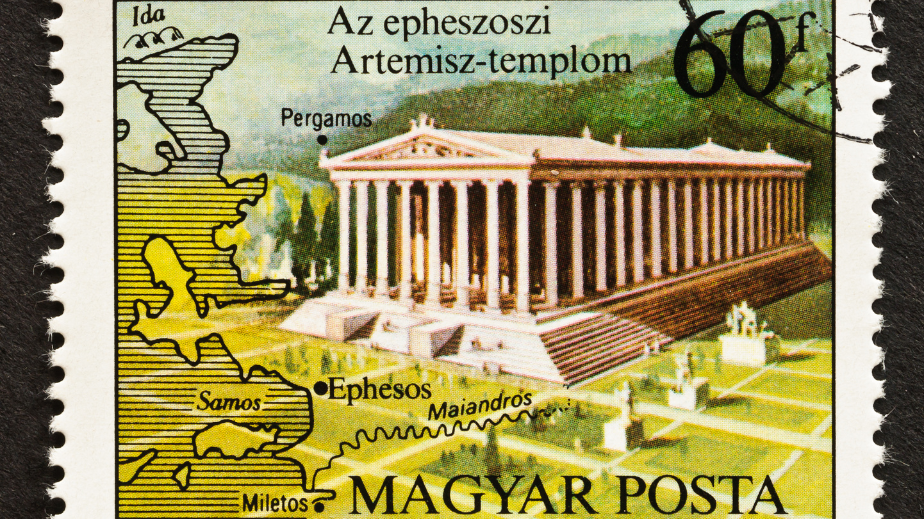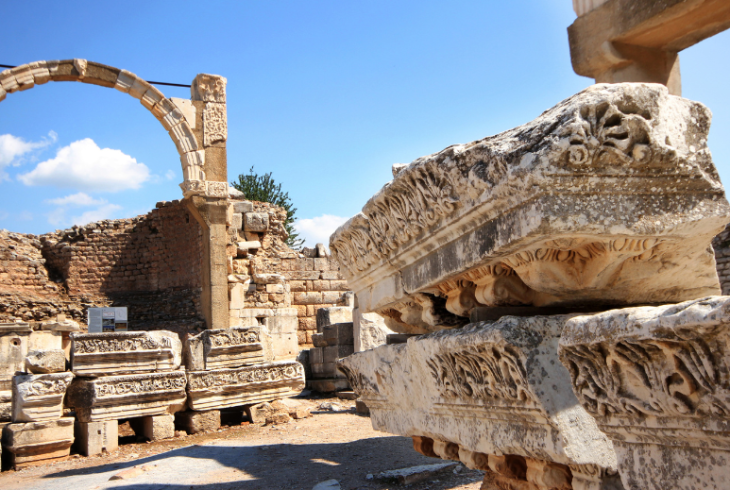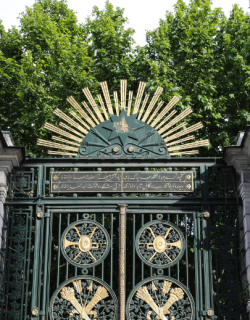The city of Ephesus, located in todays Izmir region of Turkey, was one of the most important ports in the ancient world. The city, which was the center of trade for the Mediterranean Sea, has a very old history that changed hands under the rule of many kingdoms and empires many times. Dating back to the 10th century BCE, its founding story varies from one linked to the Greek, Androklos, another to a tribe of Amazons who named the new city after their Queen, Ephesia.
This history of a city coming under the rule of so many diverse groups, from Lydians, Persians, Greeks, Romans and more, only shows the strategic importance of Ephesus and its location in antiquity. In the time of the Romans, especially during the age of Caesar Augustus to be exact, the city truly reached its pinnacle. Many of the most iconic structures visible today, such as the Library of Celsus, were built around this period.
Ephesus, Library of Celsus

The history of Ephesus
The history of this amazing city also takes many twists and turns as it later becomes one of the most important cities in early Christianity. Ephesus is linked to Saint Paul, living here and preaching among the early Christian community. Later from Rome we see his “Letter from Paul to the Ephesians”. The apostle Saint John is also said to have lived in Ephesus and possibly wrote the Gospel of John, there. According to tradition Ephesus is where Mary was brought by Saint John and she is said to have lived out her last years here. Tourists and pilgrims still come to visit the House of the Virgin Mary.
Located just outside Ephesus’ city center was another important site. This was the site which made Ephesus famous from its very beginnings in antiquity. So famous was this site, that it was considered one of the Seven Wonders of the Ancient World. Although the site today is almost all but lost to time, one can still see the impressive remains of the massive basement of what was the famous temple dedicated to Artemis of Ephesus, also knows as the Artemisium.
Ruins of the Temple of Artemis

The Artemis of Ephesus
The Greeks worshiped the divinity Artemis, and the Romans worshiped Diana, a goddess of similar attributes including the hunt, wild and domestic animals and chastity. Artemis/Diana is the older twin of the god Apollo, and daughter of Zeus and Leto (or Latona).
The Artemis of Ephesus embodied all these attributes but had a much stronger emphasis on childbirth, and fertility. Unlike Greek and Roman mythology this “mother goddess” version of Artemis was not a secondary divinity but the patron divinity of the city.
The images of the goddess differ greatly from typically Greek and Roman images in which Artemis is quite often depicted young, energetic, with a short tunic, her bow, and her hunting dog. The Artemis of Ephesus is still, wearing a specific bodice covered in animals, her chest is draped in eggs, or gourds or possibly bull testicles all symbols of fertility. On her head she wears a mural crown.
Statue of Artemis of Ephesus

Statue of Artemis/Diana

Some facts about the Temple of Artemis of Ephesus
A famous temple built in her honor dated to the time of King Croesus of the kingdom of Lydia (this was probably the second temple on the site). By the 6th century BCE, Croesus who had conquered Ephesus, began the building of the temple which was to take 120 years to complete. It was said to have been almost twice the size of the Parthenon in Greece! A column which was discovered during modern excavations of the site has a dedication in archaic Greek regarding the donation of columns by King Croesus. This column today can be found in the British Museum.
The temple was famous in its day and writing remains with thoughts and reactions to the great temple. Antipater of Sidon, a Greek poet of the 2nd century BCE wrote:
"I have set eyes on the wall of lofty Babylon on which is a road for chariots, and the statue of Zeus by the Alpheus, and the hanging gardens, and the colossus of the Sun, and the huge labour of the high pyramids, and the vast tomb of Mausolus; but when I saw the house of Artemis that mounted to the clouds, those other marvels lost their brilliancy, and I said, 'Lo, apart from Olympus, the Sun never looked on aught so grand.’"
Stamp of recreation of the temple

In the fourth century BCE, 356 the unthinkable happened. The temple was destroyed by arson. Although the culprit suffered damnation from memory, his name has been passed down through time, Herostratus.
Seeking nothing more than the desire of fame, he was tortured and executed and it was immediately forbidden to mention his name.
A legend connected to this horrific act of arson states that the temple burnt down the day of the birth of Alexander the Great, July 21st. It was thought that the goddess, so busy with the birth of Alexander must not have noticed the fire set in her own house.
The temple was rebuilt again, bigger and more opulent.
Ephesus, Decorative Detail

The Temple was damaged by the goths when they attacked Ephesus and other neighboring cities in the 3rd century CE. This wonder of the world was not long to remain. Changes in attitude also began earlier with the arrival of Saint John and Saint Paul.
Controversy began to arise as the early Christian community began to come into conflict with the larger community of followers in the cult. During the time of Paul in a reaction to loss of sales for tributes to the goddess, the silver workers who made shrines for the goddess, began a protest involving other craftsmen hit with the same financial difficulties because of loss interest for trinkets dedicated to the goddess. This protest quickly turned into a riot.
By the beginning of the 5th century, not long after emperor Theodosius’ edict of Thessalonica, making Christianity the religion of the Roman world, the temple was abandoned and as all other pagan ruins of this period, dismantled and recycled for other buildings.
Today, a visit to Ephesus cannot be complete without a walk through the site where kings, emperors, philosophers, rich, and poor alike, made their way to pay homage to the goddess, ask for her help and admire her temple, one of the most beautiful ever built.
Ephesus, Cat relaxes in the Ruins

Visit the city of Ephesus and the site of the House of the Virgin Mary with our Private Ephesus Day Trip.




